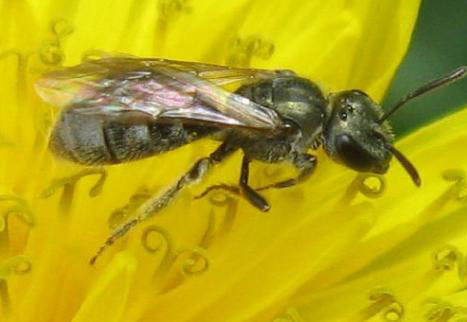- This information presented here is taken from ‘Native Bee Benefits‘ published by Bryn Mawr College and Rutgers University.
Contents |
Bombus impatiens

Common Eastern Bumble Bee
Abundance: Very common
Range: Broadly throughout Eastern US
Season: March –November
Sociality: Eusocial
Typical Flight Distance: 2-4.6 mi. (3.3-7.5 km)
Nesting: Below ground or in existing pockets such as rodent nests, under logs, stone walls. Found in a wide variety of habitats. Up to 400 workers per colony.
Foraging: Broad generalist
Recommended native plants: Asclepias syriaca, Apocynum cannabinum, Pycnanthemum tenuifolium, Cirsium discolor
Key crops pollinated: Blueberry, Cranberry, Muskmelon, Squash, Pepper, Tomato, Watermelon
Bombus fervidus

Golden Northern Bumble Bee
Abundance: Not common
Range: Broadly throughout Eastern US
Season: April-October
Sociality: Eusocial
Typical Flight Distance: 0.9-1.8 mi. (1.4-3 km)
Nesting: Above or below ground in sunny, dry locations, tend to prefer fields. Their nests may be in old rodent nests or may simply resemble field mouse nests.
Foraging: Broad generalist
Recommended native plants: Asclepias syriaca, Apocynum cannabinum, Pycnanthemum tenuifolium, Cirsium discolor
Key crops pollinated: Muskmelon, Squash, Pepper, Tomato, Watermelon
Ceratina calcarata, C. dupla and C. strenua

Small Carpenter Bees
Abundance: Common
Range: Broadly throughout Eastern US
Season: March-October
Sociality: Solitary
Typical Flight Distance: 22-87 yd. (20-80 m)
Nesting: Chews nest cells in pithy stems, rotten vines or other wood substrate. Found in a wide variety of habitats.
Foraging: Broad generalist
Recommended native plants: Erigeron strigosus, Pycnanthemum tenuifolium, Solidago odora, Euthamia graminifolia
Key crops pollinated: Muskmelon
Habropoda laboriosa

Southeastern Blueberry Bee
Abundance: Common
Range: East coast of US Season: May
Sociality: Solitary
Typical Flight Distance: 1-2.3 mi. (1.7-3.7 km)
Nesting: Burrows in dry, sandy soils singly or in groups. Found in low-lying coastal habitat.
Foraging: Specialist Recommended native plants: N/A
Key crops pollinated: Blueberry
Augochlora pura and Augochlorella aurata

Blue-Green Sweat Bees
Abundance: Common
Range: Broadly throughout US
Season: April-October
Sociality: Eusocial (Augochlorella striata) and Solitary (Augochlora pura)
Typical Flight Distance: 66-230 yd. (60-210 m)
Nesting: Soil burrowing in well-drained areas, found in a wide variety of habitats (Augochlorella striata). Burrows into rotting wood (e.g. logs, stumps) (Augochlora pura).
Foraging: Broad generalist Recommended native plants: Apocynum cannabinum, Erigeron strigosus, Pycnanthemum tenuifolium, Solidago odora, Euthamia graminifolia
Key crops pollinated: Muskmelon, Pepper, Strawberry, Tomato, Watermelon
Lasioglossum (Dialictus)

Dark Sweat Bee
Abundance: Very common
Range: Throughout eastern US
Season: April-October
Sociality: Eusocial/Rarely solitary
Typical Flight Distance: 11-450 yd. (10-410 m)
Nesting: Soil burrowing in well-drained areas. Found in a wide variety of habitats.
Foraging: Broad generalist Native plant use: Apocynum cannabinum, Erigeron strigosus, Pycnanthemum tenuifolium, Solidago odora, Euthamia graminifolia
Key crops pollinated: Muskmelon, Pepper, Tomato, Watermelon
Halictus confusus

Abundance: Common
Range: Throughout the US, Canada and Europe
Season: April-October
Sociality: Eusocial
Typical Flight Distance: 75-140 yd. (70-130 m)
Nesting: Soil burrowing in well-drained areas. Found in a wide variety of habitats.
Foraging: Broad generalist
Recommended native plants: Apocynum cannabinum, Erigeron strigosus, Pycnanthemum tenuifolium, Solidago odora, Euthamia graminifolia
Key crops pollinated: Pepper, Strawberry, Tomato, Watermelon
Peponapis pruinosa

Squash Bee
Abundance: Not common
Range: Throughout US, concentrated on east coast
Season: July-September
Sociality: Solitary
Typical Flight Distance: 0.5-1 mi. (0.8-1.7 km)
Nesting: Soil burrowing in well-drained areas, found wherever there is squash (even urban gardens)
Foraging: Specialist
Recommended native plants: N/A
Key crops pollinated: Squash
Colletes inaequalis

Plasterer Bee
Abundance: Common
Range: Throughout eastern US
Season: March-June
Sociality: Solitary
Typical Flight Distance: 0.5-1.2 mi. (0.9-2 km)
Nesting: Soil burrowing, found in large aggregations in grassy areas with inorganic soil
Foraging: Broad generalist
Recommended native plants: N/A
Key crops pollinated: Apple
Andrena spp.

Andrena carlini, A. dunningi, A. crataegi, A. regularis, A. carolina, A. milwaukeensis, A. vicina
Abundance: Not common
Range: Worldwide
Season: March-July
Sociality: Solitary
Typical Flight Distance: 140-930 yd. (130-850 m)
Nesting: Soil burrowing, sometimes found in forests or bogs
Foraging: Generalist/sometimes specialist
Recommended native plants: Apocynum cannabinum; Rosaceae, Brassicaceae, and Ericaceae families; Aruncus, Ilex, and Vibernums sp.
Key crops pollinated: Apple, Blueberry, Strawberry
Xylocopa virginica

Eastern Carpenter Bee
Abundance: Very common
Range: Throughout eastern US
Season: March-October
Sociality: Solitary
Typical Flight Distance: 5.5-13 mi. (8.8-21 km)
Nesting: Look for 0.5 in. circular holes in any wood (seem to prefer soft wood such as pine). Found in a wide variety of habitats, thrives even in cities and suburbs.
Foraging: Broad generalist
Recommended native plants: Asclepias syriaca, Solidago odora, Pycnanthemum tenuifolium, Euthamia graminifolia, Cirsium discolor
Key crops pollinated: Blueberry
Source ‘Native Bee Benefits’ published by Bryn Mawr College and Rutgers University.
